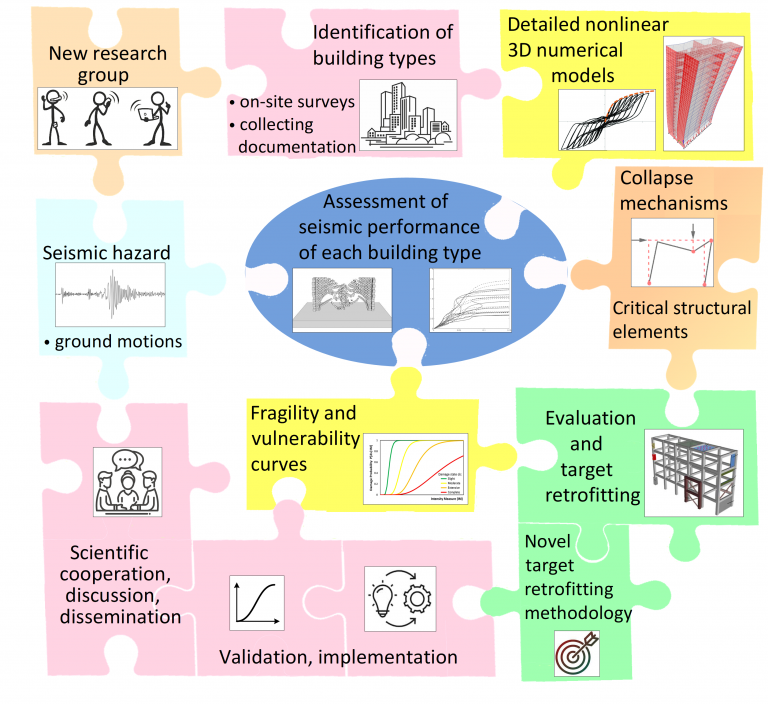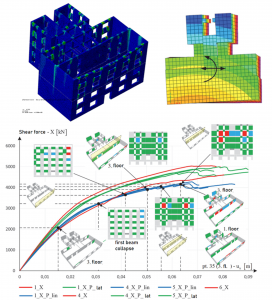2BeSafe Research Project
Seismic risk is one of the key priorities in the South-Eastern Europe region, which is rarely mentioned, although existing studies have shown that consequences of high-intensity earthquake may be disastrous. Crucial problems resulting from inadequate or non-existing vulnerability models of typical buildings in urban areas have been identified through research efforts on risk assessments. In the scope of the project 2BeSafe, new methods will be developed, and existing ones enhanced, necessary for a complete definition and description of seismic structural performance. The project focus on building types with expected high seismic vulnerability, which represent a significant part of the urban building stock in the region. In project implementation, seismic hazard for the urban location, depending on the seismotectonic conditions, will be defined and database of ground acceleration records formed. It is planned to systematically describe complex collapse mechanisms of the selected structures, develop new fragility and vulnerability models which do not exist in scientific literature and finally, to develop a new methodology for target (optimal) retrofitting of the most vulnerable building types. The described comprehensive approach to the problem opens new topics for collaboration among scientists from different fields. Therefore, an interdisciplinary research group of young scientists is being established for the accomplishment of the project goals. Aware of the importance and complexity of the problem, the team of young researchers is supported and advised by leading authorities in the research field from Croatia, but also from international knowledge centres, including young Croatian scientists abroad. This would establish a centre of excellence for advanced assessments of seismic performance and retrofit of buildings, necessary for the future development of a complete and reliable seismic risk model for the region, as well as strategies for risk mitigation.

The establishment of research group
The establishment of a new interdisciplinary research group, trained by international centres of knowledge and excellence in the field, as centre for excellence for advanced seismic performance evaluation and retrofit of buildings, and assessment of seismic risk. The group will be capable to use advanced analytical and numerical methods necessary for complex seismic analyses on its own and to develop vulnerability models for different applications, such as seismic risk assessment and mitigation, emergency response and disaster planning, and target retrofitting of substandard buildings.
Seismic hazard definition
To define model of seismic hazard which is applicable to observed region and to choose existing and develop new ground acceleration records and corresponding response spectra accordingly, in order to numerically simulate earthquake loading. Database of ground motions will be created, accounting for state-of-the-art research on seismotectonic conditions and recorded data on earthquakes from national earthquake catalogues in the region, and used as input data for advanced numerical calculations.

Identification of typical building classes with expected high vulnerability
To identify ten most vulnerable building types in the urban areas of the region which are estimated to be the most vulnerable with regard to seismic risk. The building types are expected to collapse or to be heavily damaged in the higher-intensity earthquakes, and moreover, reliable vulnerability models of them do not exist. It is estimated that more than 40 % of dwellings in the region were designed according to 10-20 times lower horizontal force than required by modern seismic codes.

Seismic performance assessment of buildings
To assess seismic performance of selected vulnerable building types to earthquakes of various intensity levels and to determine their vulnerability models, collapse mechanisms and critical structural elements, using advanced numerical models and analysis methods. The core of the project is to achieve this objective, and it is the basis for development of a new methodology for target retrofit. Comprehensive analyses conducted in scope of the project will significantly complement existing methods and definitions necessary for evaluation of load-bearing capacity and ductility of particular structural elements (e.g. capacity curves and hysteretic curves of lightly reinforced concrete walls, columns and beams with smooth reinforcement bars with inadequate lap splices and anchoring lengths), for which there are very few experimental data.

Development of methodology for target retrofit and seismic performance assessment of retrofitted buildings
To establish new methodology for target retrofit of substandard buildings and to assess seismic performance of retrofitted buildings. This will enable targeted action into the load-bearing system by locally reinforcing key structural elements which participate in the creation of the collapse mechanism, thus increasing the level of safety of the building and its occupants to an acceptable level that will not be strictly determined, but will depend on a number of parameters (building importance, costs, time, etc.).

Project proposals applied for other funding sources
To establish collaboration with leading researchers in the field, to position the research group as the centre of excellence for advanced assessments of building performance, seismic risk assessments and methodology of target retrofit, and to disseminate the results and implement them in scientific databases. Research group will be sustainable through competitive participation in European Research Area, as new project proposal will be applied for other funding sources.


